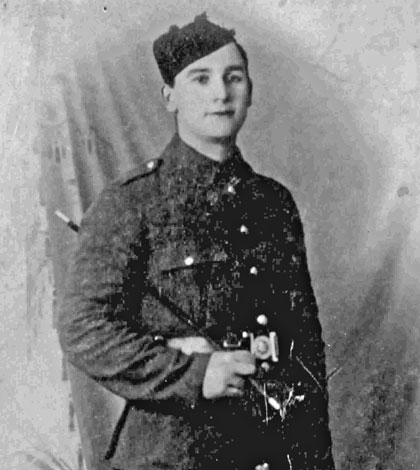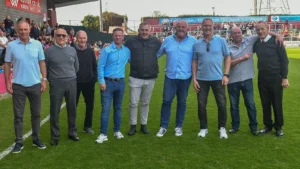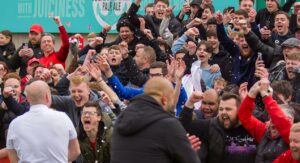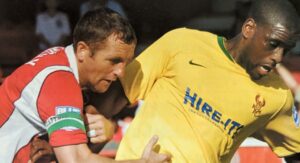One of the more resonant legacies of the First World War is that of the unknown soldier, the collective term for those unidentified bodies “known unto God”.
William Kennedy, another star of the Northfleet United treble-winning side of 1909-10, who lost his life at the Battle of Loos in October 1915, was one such ‘unknown soldier’, his body never found in the carnage that resulted in 60,000 British casualties.
Born in Grays, Essex, in 1890 to John Kennedy and Jeanie McKenzie, the fourth of eight children, William was a schoolteacher and also proved to be adept on the football field. He played amateur football for his local side, Grays Athletic, and moved to Northfleet in 1909 alongside another signing, a then-unknown teenager called Charlie Buchan who would go on to become a famous Arsenal and England player and later a well-known journalist.
 By the time he starred for the ‘Cementers’ (as the Fleet were also known) in the 1910 Kent Senior Cup Final, he was in high regard. The South Eastern Gazette said of him, “Kennedy is the sharpshooter of the Cementers. He came to Northfleet as a diamond in the rough. He could do nothing but shoot. Now he not only shoots, but he passes and repasses with the skill of the artiste. To watch Kennedy is to follow one of the best features of Northfleet’s play. Probably the Cementers best catch of the season.”
By the time he starred for the ‘Cementers’ (as the Fleet were also known) in the 1910 Kent Senior Cup Final, he was in high regard. The South Eastern Gazette said of him, “Kennedy is the sharpshooter of the Cementers. He came to Northfleet as a diamond in the rough. He could do nothing but shoot. Now he not only shoots, but he passes and repasses with the skill of the artiste. To watch Kennedy is to follow one of the best features of Northfleet’s play. Probably the Cementers best catch of the season.”
Kennedy scored Northfleet’s opening goal in the 2-0 final defeat of Chatham, which by a curious twist of fate he headed home from a corner taken by the other casualty of the war, Edwin Myers. Moreover, in the 1910 Northfleet team line-up photograph (Kennedy pictured in it, above), he is sat directly behind Myers.
Kennedy was instrumental, too, in Northfleet’s third Kent League title in succession, scoring more than 50 goals in all competitions (which included the Thames & Medway Combination, also won by the Fleet) in that successful season and according to John Jones’ history of Northfleet United was “considered by many to be the equal of Buchan”.
He turned out for Southend in several guest appearances and it was no surprise that he was picked up by West Ham United, then managed by Syd King who had been Northfleet’s skipper back in 1895.
Kennedy scored on his debut against Brighton & Hove Albion. Playing alongside West Ham, Blackburn and Fulham legend Danny Shea he scored four goals in 10 league games that season. He also did well the following year scoring a hat-trick against Brentford on October 21, 1911. Unfortunately he suffered a serious knee injury in an FA Cup tie against Middlesbrough on February 8 the following year and was unable to play professional football again.
On the outbreak of the First World War, Kennedy joined the British Army as a lance corporal. He volunteered for the London Scottish Regiment in deference to his roots (his father hailed from Lanarkshire and his mother from Ayrshire).
Depending how early on in the war he signed up, as part of ‘A’ Company 1/14th County of London Battalion, it is possible he saw action in some of the famous early engagements of the war including the Battle of the Marne, the retreat from Mons, Messines and Ypres.
One can only imagine what a terrible year 1915 was for the Kennedy family. On September 12, William’s elder brother John was killed at Gallipoli. He was Fourth Engineer Officer on the troop ship HMS Minnetonka and had previously taken part in the famous landings at Anzac Cove. He was buried at Mudros Cemetery on the Greek island of Lemnos.
Within a month, William would have met the same fate. Two weeks after his brother’s death, his battalion was ordered to Loos as part of the largest British offensive of 1915.
The attack began on September 25 and by mid-October the objective, a fortified position known as the Hohenzollern Redoubt, had changed hands between the British and Germans several times. There were 20,000 casualties in the first two weeks and the British were back at their starting positions. On October 13, they made one final push.
At 1400 hours, Kennedy was part of the unit launching a new attack. The German defences and wire were untouched by the feeble artillery barrage and with German shells now landing heavily around the attacking troops, the outcome was doomed. With immediate heavy losses of officers and men (across the entire attack front, there were 3,643 casualties, mostly in the first 10 minutes), the survivors were left facing impenetrable wire with little cover and no way to get through. The men of Kennedy’s ‘A’ Company were some of those who reached the furthest forwards.
Whilst this halt in the ‘advance’ was forced upon the men, and they did their best to seek cover, a call was made for volunteers to cross the shell-swept zone to the dressing station in order to obtain aid for wounded comrades. Lance Corporal Kennedy and two others volunteered to go and they were last seen crossing the area amid the falling shells. It was foggy at the time and for some considerable period afterwards there was hope that they had lost their way and become prisoners. The hope was futile, however, and it can only be presumed that Kennedy was killed in the shelling as no trace of him or his two fellow volunteers was ever found.
The official history of the battle suggested that, “The fighting on October 13-14 had not improved the general situation in any way and had brought nothing but useless slaughter of infantry.”
Like so many others killed on the Western Front, Kennedy had no known grave and was commemorated on the nearest memorial to where he vanished, in this case the Loos Memorial where his name is joined by 21,000 others. He is also remembered on his local Grays war memorial alongside his brother (below), and on his parents’ headstone.

Described by the South Eastern Gazette after his 1910 Kent Senior Cup-winning performance as “a genial, kindly soul”, it is perhaps no surprise that this sporty schoolteacher died trying to help others, with no thought for his own safety.




